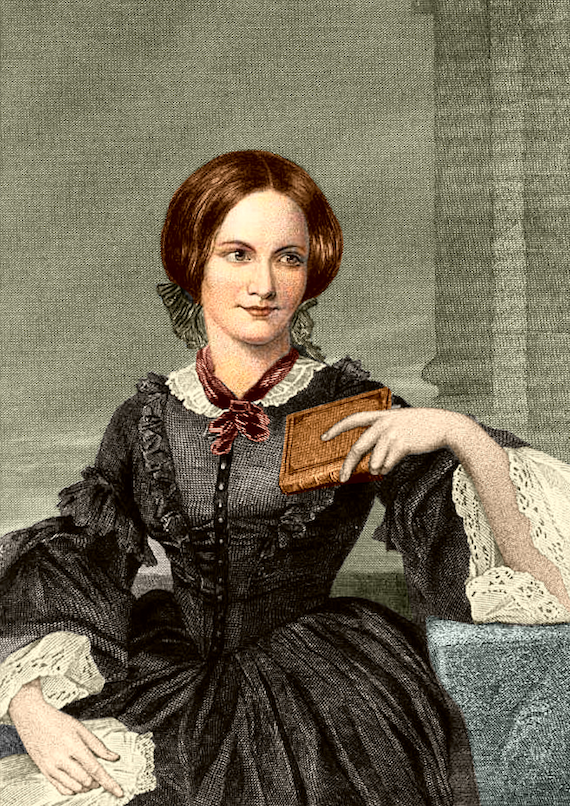
As we celebrate Charlotte Brontë’s 201st birthday this month, it’s hard not to feel awe for a woman who not only rose to literary stardom against all odds, but managed to keep her storied place in literary history for two centuries.
Evidence of Brontë’s enduring popularity is everywhere, not least in the large number of adaptations and re-tellings her books have inspired. Spin-offs have produced wonderfully beloved novels in their own right, and their pace of production doesn’t seem to be slowing down. Check out these six books — wildly different in tone and style — that all share the same inspiration: Charlotte Brontë.
 1. The Eyre Affair, by Jasper Fforde
1. The Eyre Affair, by Jasper Fforde
The Eyre Affair takes place in an alternative 1985, where you can, quite literally, become lost in a novel. The protagonist, Thursday Next, is a seasoned “literary detective” who faces a career-changing challenge the day that Jane Eyre is suddenly and inexplicably kidnapped from her own novel. “The barriers between reality and fiction are softer than we think,” warns one Fforde’s characters, “a bit like a frozen lake. Hundreds of people can walk across it, but then one evening a thin spot develops and someone falls through; the hole is frozen over by the following morning.” A fun, clever read for anyone who loves speculative fiction.
 2. Reader, I Married Him, edited by Tracy Chevalier
2. Reader, I Married Him, edited by Tracy Chevalier
Jane Eyre’s famous line, “Reader, I married him,” is the springboard for this recent short story collection, which features Brontë-inspired short stories from 21 of today’s great female writers, including Helen Dunmore, Sarah Hall, Emma Donoghue, and Evie Wyld. The central quote is an important one; “Reader, I married him” was a revolutionary declaration in 1847. Jane was not being chosen — rather, she was doing the choosing. Brontë fans will particularly enjoy the stories told from the perspective of Rochester and Grace Poole.
 3. Rebecca, by Daphne du Maurier
3. Rebecca, by Daphne du Maurier
This is terrific read for anyone who loves mystery, romance, and Jane Eyre. Rebecca, while not a governess, is similarly undignified as a “paid companion.” Both Rebecca and Jane are barely adults when they meet their mysterious future husbands, both men with dark secrets in their past (the secret in each case is an estranged wife). Both Jane and Rebecca go to live in a gothic manor that is, conveniently, brimming with secrets. However, the comparison between the two novels is not perfect, and Rebecca has many delightful surprises of its own, the most interesting being the oft-debated subtext surrounding Mrs. Danvers. If you love the book, definitely watch Alfred Hitchcock’s film adaptation.
 4. The Brontë Cabinet: Three Lives in Nine Objects, by Deborah Lutz
4. The Brontë Cabinet: Three Lives in Nine Objects, by Deborah Lutz
It’s hard to believe there’s anything left to reveal about the Brontës’ lives, but Lutz proves us wrong! This detailed biography tells the story of the Brontë sisters through the lens of the physical objects they used every day, from their portable writing desks to their walking sticks. Each possession paints an intimate picture of the Brontës and gives us a unique window into their lives. One of the most powerful chapters centers around an amethyst bracelet Charlotte wore after the death of her sisters. The bracelet is made from the hair of Anne and Emily, a symbol of Charlotte’s grief and enduring affection.
 5. Wide Sargasso Sea by Jean Rhys
5. Wide Sargasso Sea by Jean Rhys
In this spell-binding novel, Rhys gives us the prequel to Jane Eyre, starting from when Bertha (then named Antionette Cosway) was an heiress living in Jamaica. Rhys uses the backstory of Jane Eyre’s infamous madwoman to explore the legacy of colonialism, and what happens to a woman who no longer has control over her life. Suffering from a deep identity crisis and spiritual suffocation at the hands of her husband, we learn how and why Bertha spirals into insanity. “I often wonder who I am and where is my country and where do I belong and why was I ever born at all,” she says.
 6. Jane Steele, by Lyndsay Faye
6. Jane Steele, by Lyndsay Faye
Reader, I murdered him? In this Brontë-inspired novel, Jane Steele is a orphan who appears similar to Jane Eyre except for one small thing: she’s a serial killer. The novel explores what happens when a defenseless underdog in Victorian England takes an inner rebelliousness to the ultimate extreme. In an interview with Read It Forward, Faye explains her unorthodox choice: “Is Jane Steele right to consider herself evil? If you kill for self-defense, is that unforgivable? What about killing for love? What about killing to protect a helpless child from a predator? When is doing the wrong thing actually the right thing?”
Image Credit: Wikimedia Commons.









